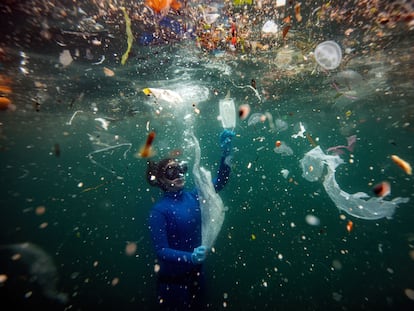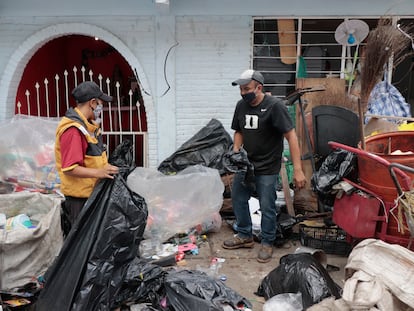‘Penguins nesting in boxes’: Valdés Peninsula, a heritage site awash in plastics
In Argentina, popular outrage has prompted the government to speed up the cleanup of this UNESCO protected area, which is plagued by tons of crates, nets, buckets, gloves and other plastic refuse
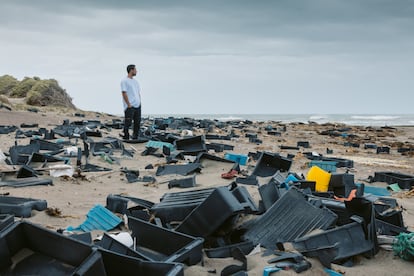
In recent weeks, images of plastic waste on the shores of Valdés Peninsula --a protected site in Chubut province, which has one of the world’s richest marine ecosystems-- have sparked outrage in Argentina. According to government estimates, there are 40 tons of broken crates, buckets, gloves and nets from fishing activities in the area.
A veritable sea of plastics has been accumulating for months in Punta Delgada, Estancia El Pedral, Bahía Cracker, Punta Cormoranes and the islands of Tova and Tovita, which are part of the 887,000 hectares of land and sea that make up the UNESCO Natural Heritage of Humanity site (it was given that status in 1999).
The news exploded on the front pages of Argentine newspapers in April, following complaints about delays in the cleanup. The removal of waste eventually began in the last week of April and will continue until the end of May, as long as fauna is not found on the coast. Now, the issue is resolving the cause of the problem: why is there so much garbage from the fishing industry being thrown into the ocean in the first place?
The Valdés Peninsula is a nature sanctuary where penguins nest and the southern right whale breeds, and it is the natural habitat of elephant seals, sea lions, dolphins, orcas and countless birds. “I saw injured animals on top of the plastics and, in Tovita, penguins are nesting inside the boxes; one also sees some dead [penguins] surrounded by garbage on the coast,” says Yago Lange, a former Argentine Olympic sailing athlete and an ambassador for Parley of the Oceans, an international organization that works to preserve the oceans.
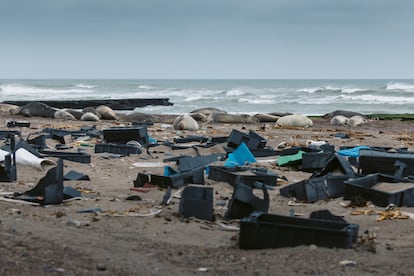
For some time, Lange has been sounding the alarm about the beaches polluted by waste from fishing boats, denouncing the delays in removing the waste and documenting the situation. He says that the state of affairs has worsened in the last six months.
Provincial and national authorities and the fishing industry recognize the problem. The Vice Minister of Environment, Sergio Federovisky, has spoken of the urgent need to identify the perpetrators of what he described as a “criminal action against the environment” and to sanction the guilty parties. “It is necessary to understand the dynamics in which…[someone] decides to brutally and maliciously externalize its costs by dirtying such a valuable natural resource like the coastal areas of the province of Chubut,” the official said.
Chubut’s Undersecretary of Environmental Management, Fernando Pegoraro, has admitted that the amount of waste on the coast has increased over the last five years, but he notes that inspections of the area are more comprehensive. The province of Chubut has 1,600 linear kilometers of coastline. Almost a third of them are inaccessible because of the area’s cliffs, where waste accumulates after being dragged there by winds and tides.
According to Pegoraro, two parts of the area are particularly affected by this situation. One is a 3-kilometer stretch of beach where the authorities estimate there is “about 100 cubic meters of garbage.” They have also detected “another 100 cubic meters [of refuse]” in a 7-kilometer area of beach on two islands. One cubic meter is equivalent to 200 kilos (440.9 pounds) of waste. Based on that estimate, there’s at least 40 tons of garbage. “The fishing industry is obviously the guilty party, but we cannot determine the ship or the company [and we don’t know] whether [the fisher] is national, provincial or international,” the official said.
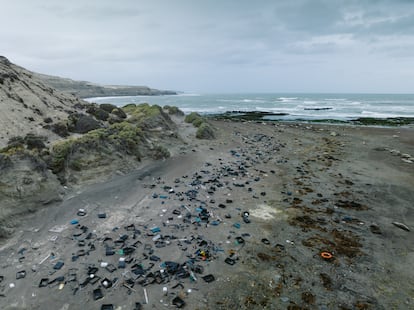
Seeking solutions for the problem
The crates used for fishing only identify the refrigeration company that delivers the caught fish; they do not indicate the vessel that transports them. As a result, it is impossible to know where they come from or who is discarding them. Since March, the Instituto Patagónico de Ciencias Sociales y Humanas (Patagonian Institute for Social and Human Sciences) has been working to solve this problem and will offer the results in July.
Jorge Frías, the general secretary of the Argentine Association of Fishing Captains, points out that Navigation Law No. 20094—which states that the captain must guarantee that nothing falls into the sea—must be enforced. But that isn’t enough. “All the materials should be marked with the information, the vessel’s colors or symbols,” he proposes. In addition, he suggests that the shipowner be jointly and severally liable for compliance.
To that end, a regulation on the mandatory marking and identification of trawling gear and the mandatory declaration of the number of crates with which vessels set sail and arrive at port was approved on May 9. For the time being, fishing vessels must have obligatory on-board crampons and gaffs to facilitate the recovery of crates that fall into the sea.
The only regulation currently in effect to help mitigate the presence of plastics and microplastics in the sea is one that targets the capture of spider crabs. The fishing industry recognizes the need to resolve the issue but defends its role as a generator of foreign currency and work.
Frías, who has been sailing the Atlantic since he was 17 (in 1985), says that, since then, he has seen remains of plastic crates and synthetic elements from fishing in the sea and on the coast. But he believes that sailors’ attitudes have changed over time. “For many years now, we fishermen have not thrown plastics and debris [into the water],” he says. Instead, he observes, fishers keep waste on board until they go ashore.
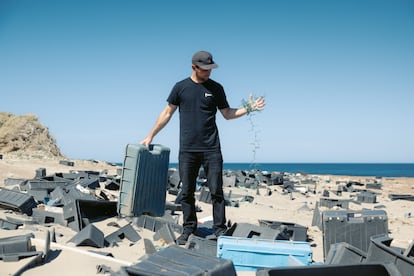
Another difference is that the fishing fleet has expanded, along with the number of crates used to preserve fresh seafood. “There’s clearly more waste being found because of the fishing industry’s expansion and because there are more tools to give [the problem] [much greater] visibility,” says the unionist. In addition, Frías points to other culprits. He says that plastic waste also comes from the cities.
The president of the Argentine Patagonian Chamber of Fishing Industries (Capip), Agustín de la Fuente, says that the fishing industry is also cooperating to solve the problem. “We want to be part of the solution. The Atlantic is a rough, robust, cold sea, where there are storms and the crates can fall; it’s not done maliciously,” he asserts. “It is incoherent to think that the fishing industry worker is generating this impact of his own free will. Unfortunately, it is happening, [and] we have to look for a solution.”
Lucía Castro, the director of Sin Azul No Hay Verde (Without Blue There’s No Green), an organization that defends marine biodiversity, believes that there’s little control and oversight of the fishing sector. “It is an industry that has always done what it wanted in the sea,” she says. The environmentalist recognizes that there are factors that are out of the industry’s control, such as weather conditions, but she maintains that there is no justification for poor waste management at sea or in the ports.
“There is the figure of the observer on board who has to go onto the ships and check that everything that should happen actually does happen, but that doesn’t occur. There are not enough inspectors, there is no control on the ships or in the port, either,” she points out. But National Director of Inspection Julián Suárez claims that control and inspection are done constantly.
In addition, Castro believes that there’s an invisible environmental problem that lurks behind the crates—trawling, which, like clearing land, devastates the seabed with fishing nets that pick up whatever they find in their paths. According to industry estimates, 30% of what nets catch is discarded and thrown overboard.
Sign up for our weekly newsletter to get more English-language news coverage from EL PAÍS USA Edition
Tu suscripción se está usando en otro dispositivo
¿Quieres añadir otro usuario a tu suscripción?
Si continúas leyendo en este dispositivo, no se podrá leer en el otro.
FlechaTu suscripción se está usando en otro dispositivo y solo puedes acceder a EL PAÍS desde un dispositivo a la vez.
Si quieres compartir tu cuenta, cambia tu suscripción a la modalidad Premium, así podrás añadir otro usuario. Cada uno accederá con su propia cuenta de email, lo que os permitirá personalizar vuestra experiencia en EL PAÍS.
¿Tienes una suscripción de empresa? Accede aquí para contratar más cuentas.
En el caso de no saber quién está usando tu cuenta, te recomendamos cambiar tu contraseña aquí.
Si decides continuar compartiendo tu cuenta, este mensaje se mostrará en tu dispositivo y en el de la otra persona que está usando tu cuenta de forma indefinida, afectando a tu experiencia de lectura. Puedes consultar aquí los términos y condiciones de la suscripción digital.
More information
Archived In
Últimas noticias
How Japan is trying to avert ‘digital defeat’
From digital curfews to blocking apps: How technology experts protect their children online
Why the price of coffee has skyrocketed: from Brazilian plantations to specialty coffee houses
Confined to a Cuban hospital: When electricity is a matter of life or death
Most viewed
- Pablo Escobar’s hippos: A serious environmental problem, 40 years on
- Reinhard Genzel, Nobel laureate in physics: ‘One-minute videos will never give you the truth’
- Why we lost the habit of sleeping in two segments and how that changed our sense of time
- Charles Dubouloz, mountaineering star, retires at 36 with a farewell tour inspired by Walter Bonatti
- The Florida Keys tourist paradise is besieged by immigration agents: ‘We’ve never seen anything like this’
